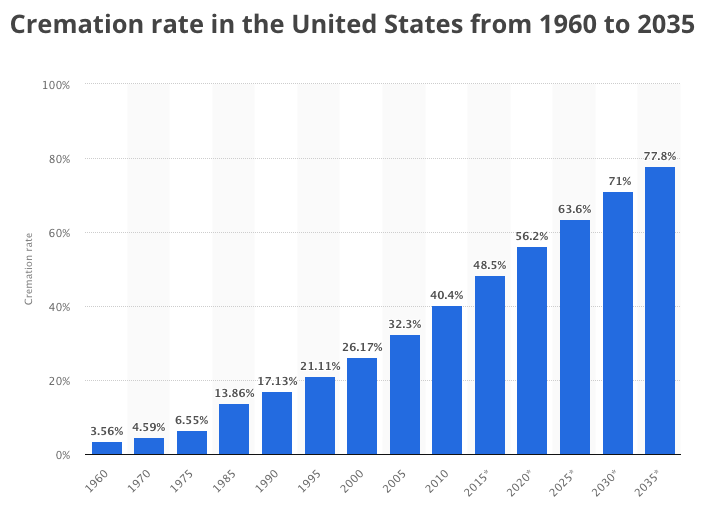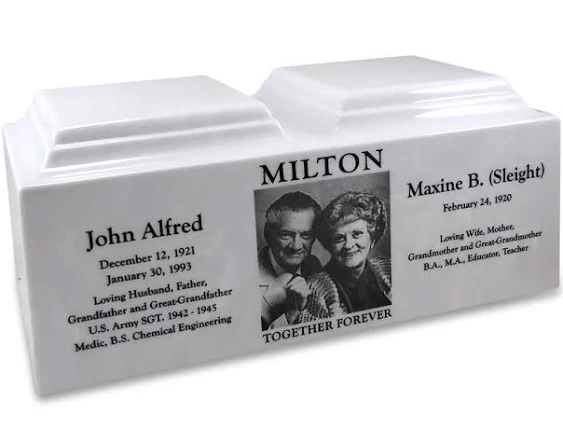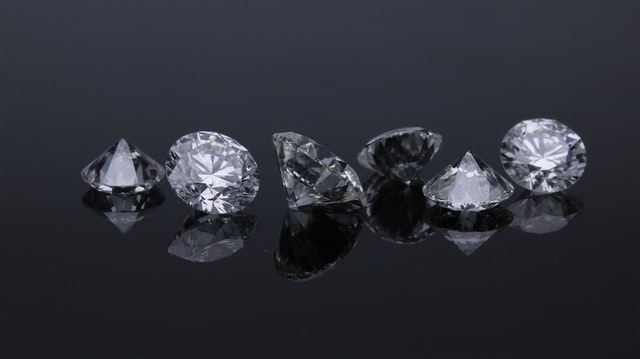Chronicling the Substantial Rise in Cremation Rates Across the United States
The process of cremation has existed for thousands of years and became officially recognized in the United States in 1876. That year, the first U.S. crematorium was built in Washington, Pennsylvania (and not without some controversy, mind you). Although it was official, cremation struggled to gain hold within the general population for 90 years. By the 1970s, cremation rates were just around 5 percent. But in the decades that followed, that rate began to rise at a steady rate. So much so that it has now become the most popular way to memorialize the deceased in the United States.
Viewpoints Evolve in the U.S.
A few momentous changes in U.S. society have contributed to this astonishing rise of cremation. One of these changes is the increasingly secular view among the general population. In decades and centuries past, many religions discouraged cremation, if not banned it outright. The reason centered around views of resurrection, believing that the deceased must be buried in consecrated ground. As views changed, the positions of many churches followed suit and took a more relaxed view regarding cremation. Coupled with increasingly secular views, the move toward a more mobile and far-flung society has also played a role in the rise of cremation. With family members often living states, even countries away, cremation can be a more convenient choice when scheduling a memorial for all members to attend. Similarly, this geographic separation has also disincentivized burials because it means many will not be able to regularly visit the loved one’s resting place.
The cost of burial versus cremation is occasionally mentioned as a deciding factor as well. According to the NFDA, the median price of a funeral with viewing and burial was $7,848 in 2021. This was considerably higher than the median cost of direct cremation, which was $2,550. It is worth noting, however, that cremation with a viewing and funeral is somewhat comparable to a traditional burial at a median cost of $6,970.
Susan Dice, director of customer care at Thumbies, has a decade of experience in the industry and offered this theory: “As a society, we are much more mobile than ever before. We live farther away from family members and don’t necessarily stay in one town or area.” She continued, “In the past, people would grow up and old in one town and be buried in the family plot in the local cemetery. Cremation allows people to do a memorial at a future date, giving more time to plan and hold a celebration of life that is truly special and meaningful to the people left behind. People have time to remember and celebrate their loved one, instead of potentially feeling numb and steeped in grief during a more quickly organized and -held traditional service.”

As of 1999, there were 1,468 crematories and over half a million cremations, a rate of 25% of all the deaths in the United States. By 2019, that had grown to over 3,000 crematories and more than 1.5 million cremations, representing over 54% of U.S. deaths. The Cremation Association of North America (CANA) projects the cremation rate will hit just under 80% by 2040 as the Baby Boomer and Gen X segments continue to reach their senior years and people become more comfortable with alternative methods.
Carol Lynn DeFiore, owner of DeFiore Funeral Home in Huntley, Illinois, confirmed that this rise in cremation is very real, saying, “We have seen an uptick in cremation but also an uptick in total deaths for our home, since the height of COVID. Cremation is not going away, but years ago everyone had the same funeral. Today there are just more options, giving families more ways to celebrate their loved one's lives. We have found that many of the families who choose cremation are honoring the wishes of their family member.”
She continued, “The industry is changing rapidly, and I believe that we must always remember that a family comes to us because they need us. They need direction, they need us to listen and to know their family member matters, and that no matter how it looks, it is our responsibility to provide that for them.”
What to Do in a Rapidly Evolving World
So how can funeral homes and directors best serve their families in this changing environment? First and foremost, make sure you are at the cutting edge of technology and changes. Be ready to serve your families with the request for cremation, and whatever might come with that. Whether that means educating yourself and your staff, becoming a certified cremation specialist, or even going as far as to add a crematorium to your property (local and state laws and regulations determining what is permissible, of course), we all must be at the forefront to continue to be successful.
Enrolling in courses that you attend at events/shows, in-person or online, is a good choice for continuing cremation education. Check with OGR, NFDA and CANA for programs and information to become a certified cremation services provider as well as additional educational sessions. Staying up-to-date will only behoove homes as funeral services change and cremation rates (as well as green burials) continue to rise.
Suggestions for What Families Can Do (and have done) with Cremated Remains

While the popular option continues to be to store remains in an urn and keep them at home or even split them among family members, there is a growing trend toward personalizing how an individual is memorialized after cremation. Ideas from CANA include:
- place the urn in a columbarium or other type of niche, sealed or not, in order to have a physical location to visit
- combine remains (as of two parents, both now deceased) and scatter in a place that had meaning to the family, as a state park, a waterway or other place of significance (always check local regulations first)
- place the remains in an eco-friendly urn and bury it so everything returns to the soil and earth around it
 create a diamond or other piece of jewelry that incorporates remains into the piece that can be kept close to the wearer for comfort
create a diamond or other piece of jewelry that incorporates remains into the piece that can be kept close to the wearer for comfort- store inside objects such as a holiday ornament, a glass paperweight, an hourglass or other items that can easily be part of the décor in a home
- tattoo – cremated remains can be mixed with ink and tattooed on an individual
- fireworks – remains are incorporated into fireworks or rockets and shot off in a custom display
While these methods may seem unusual to some funeral directors, grieving families have become more open to new, non-traditional methods to find closure in the passing of a loved one. The rise of cremation has given families more freedom to find that closure for themselves.
Other, greener, methods of aftercare include water cremation (also known as alkaline hydrolysis, the option chosen earlier this year following the death of Archbishop Desmond Tutu), as well as green burials that take place without the use of embalming or any sort of chemicals and use only a wooden casket or even simply a shroud in the burial space. While these methods are rapidly gaining in popularity, they are not (yet) considered mainstream - but are still worthy of time to research and consider.
Whether cremation levels continue to rise as expected, the funeral industry and individual providers will serve families best when we are all better educated and prepared, staying ahead of the trends. Investing our time (and that of our teams) in educational programs and being open to considering non-traditional services and offerings will be important to our business (and community) as we move forward.
This message was originally published in the Summer 2022 issue of The Independent® magazine. Click here to read the entire issue.
 Wayne Read is the CEO of Thumbies Keepsakes, the leading provider of fully cast, handcrafted memorial keepsakes produced in the U.S. Heartland. He can be reached at Wayne.Read@ Thumbies.com. For more information, visit www.Thumbies.com.
Wayne Read is the CEO of Thumbies Keepsakes, the leading provider of fully cast, handcrafted memorial keepsakes produced in the U.S. Heartland. He can be reached at Wayne.Read@ Thumbies.com. For more information, visit www.Thumbies.com.

